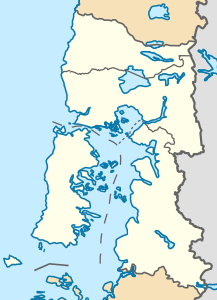Reloncaví Fjord
| Reloncaví Fjord Estuario de Reloncaví |
||
|---|---|---|
|
Reloncaví Fjord near its confluence with Reloncaví Sound |
||
| Waters | Reloncaví Sound ( Pacific Ocean ) | |
| Land mass | Mainland South America | |
| Geographical location | 41 ° 41 ′ S , 72 ° 24 ′ W | |
|
|
||
| width | 3 km | |
| length | 55 km | |
| Islands | Marimeli Island | |
| Tributaries | Río Petrohué , Río Puelo | |
|
Map of the area |
||
Reloncaví-Fjord ( Spanish Estuario de Reloncaví ) is the name of a long, narrow fjord in southern Chile .
It opens east of Reloncaví Sound , a large inland basin south of the district capital Puerto Montt , and runs in a curved J shape first to ONE and after a bend approximately in its middle in NNE - direction. It is entirely located in the Chilean region X ( Región de los Lagos ). The Reloncaví Fjord is the northernmost Chilean fjord and one of the closest to the equator in the world .
In its immediate vicinity are the Chilean national parks Vicente Pérez Rosales , the National Park of Hornopirén , the Parque Nacional Alerce Andino and the nature reserve Llanquihue , as well as the impressive volcanic cones of Osorno , Calbuco and Yate . Today it is one of the centers of Chilean farmed salmon production due to its depth and its generally favorable water conditions .
Geographical and hydrological details
The fjord is 55 km long and at its widest point no wider than three kilometers. Its average width is 2 kilometers. It opens on the east side of Reloncaví Sound, the northernmost part of the Chilean inland sea between the mainland and the island of Chiloé . The fjord initially runs in the ONE direction and turns more towards the north around its center. In its first third is the inhabited island of Marimeli. Two rivers flow into the Reloncaví Fjord, as well as several streams: the Río Petrohué in the north and the Río Puelo in the middle of the east coast. In addition to the frequent and abundant rainfall, these rivers contribute significantly to water renewal and influence the salinity of the fjord. Between its opening from the Sound and Marimeli Island, the fjord is an average of 400 m deep, in the bend area the average depth is about 200 m, and in the northernmost third is less than 100 m. The average depth of the entire fjord is 170 m. The two flowing rivers form large boulder deltas; shallow brackish water lagoons have formed in their area . The salinity of the fjord varies both regionally and seasonally. It is around 1.7% in the north and 4.5% at the mouth. The amplitude of normal tides is just over a meter, but spring tides can reach an amplitude of up to 6 meters. In contrast, the tidal range in Reloncavi Sound can exceed 10 m.
Fishing industry
The Reloncaví Fjord is one of the centers of Chilean farmed fish production, which began in the 1970s and is now an important economic factor. Above all, salmonids such as Atlantic salmon , silver salmon and king salmon are bred, and brown trout and rainbow trout in the river mouths . Escaped specimens of the king salmon have built self-sustaining populations and rise annually in some Chilean rivers, including the Río Petrohué, to spawn. The other two salmon species do not seem to have succeeded in this so far. However, rainbow trout and, to a lesser extent, brown trout are the most common fish species in many Chilean rivers and are increasingly displacing the few native species. In the past, the fjord was mainly fished for the Robalo ( Eleginops maclovinus ) and the Merluza de cola , a species of hake .
literature
- Arnoldo Valle-Levinson, Nandita Sarkar, Rosario Sanay, Doris Soto and Jorge Leon: Spatial Structure of Hydrography and Flow in a Chilean Fjord, Estuario Reloncavı . In: Estuaries and Coasts Vol. 30, No. 1, pp. 113-126; February 2007.
Web links
Individual evidence
- ↑ Valle-Levinson et al. (2007) p. 114
- ↑ Valle-Levinson et al. (2007) pp. 114-117
- ↑ Doris Soto et al .: Establishment of Chinook salmon (Oncorhynchus tshawytscha) in Pacific basins of southern South America and its potential ecosystem implications . In: Revista Chilena de Historia Natural 80: 81-98, 2007. pdf span / engl.
- ↑ Chiles fish (Robalo) span.
- ↑ Chilean fish (Merluza) span.


